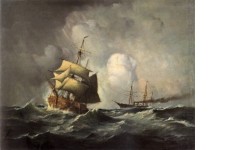TITLEBREAKING THE WAVES
MEASUREMENTS (cm)Height : 58
Width : 74
USED MATERIALSOil painting (Oil on canvas laid down on panel)
SIGNATURELower Right
CHRONOLOGY01-01-1875
AUTHENTICITY CHECKNot checked

Provenance:
Descendants of the artist.
Private collection, Athens.
The largest and most important oil by Altamura ever to appear on the open market, Breaking the waves is one of the few and extremely scarce but highly admirable works by an exceptional talent whose promising career was cut short at the age of 26. 1 A pioneering Greek seascapist, having emerged a decade before Constantinos Volanakis2, "Altamura epitomizes the deepest meaning of impressionism. In his seascape painting he tries to capture the fleeting natural phenomena - travelling clouds and reflections of light flickering on the waves. His brushstroke is free, while his pure and vibrant colours are coupled with complementary ones, adding vitality and luminescence to the painted surface." 3
Painted in 1875, one year before he returned to Greece from Copenhagen, Breaking the waves is a splendid portrayal of a sailing vessel surging through choppy seas, lovingly delineating every detail of masts, sails and rigging. A shimmering sky shines between luminous white clouds, while cool green waves animated by white splashes - a vivid response to the colour of the clouds - sparkle beneath the brown hull of the sailing craft. The masted steamship on the horizon, portrayed in full length, demonstrates Altamuras deft use of the point of brush to suggest details. His command of areas of space is as impressive as the delicacy with which he suggests the movement of waves, while the shifting atmosphere and the mobility of light have been recorded with an effortless brilliance that recalls the finest work of R.P. Bonington. 4
Beautifully composed, this vigorous painting is a fine example of Altamuras mature style, demonstrating assurance of technique rarely found in so young an artist. With fluid, dexterous brushstrokes and skilful rendering of the quality of light and shade, he conveys an extraordinary effect of recession towards the horizon. This, combined with his fondness for placing the horizon low in the composition, contributes to the illusion that the vast expanse of sky and sea extends far beyond the limits of the framed canvas. Capturing the breadth and freedom of the unfathomable sea in a manner that usually eludes the painstaking style taught and preached at the academies, the young painter develops a fresh approach to the seascape, "transforming natural elements into a lyrical image." 5
Son of the Italian painter Saverio Altamura and the Greek painter Eleni Boukoura, Jean Altamura received his first art lessons from his mother, and in 1871-1872 studied at the Athens School of Fine Arts under Nikiforos Lytras. A natural talent, he won a scholarship from King George I that enabled him to continue his studies (1873-1876) at the Academy of Fine Arts in Copenhagen under the distinguished seascape painter Carl Frederic Soerensen. During his stay in Denmarks capital he participated frequently in group shows and also sent paintings to exhibitions in Athens, which won him several distinctions. Suffering from tuberculosis, he returned to Greece in 1876 and settled on the island of Spetses where he died two years later. 6
According to M. Vlachos, a distinguished scholar of Greek marine painting, "though he died young, Altamura produced a substantial oeuvre, which testifies to his creative ability and awareness of the artistic trends of his time - not only of the Danish or Flemish schools but also of British and French marine painting. Equally sensitive to nature and as masterful in technique as Volanakis, he proved to be more spontaneous." 7 Indeed, as noted by Athens National Gallery Director M. Lambraki-Plaka, "Altamura penetrated so deep into the philosophy and technique of impressionism, that he could be considered one of its forerunners on a European level." 8
1. A. Ioannou, Greek Painting - The 19th Century, Melissa publ., Athens 1974, p. 204.
2.. F. Yofyllis, History of Modern Greek Art [in Greek], vol.1, To Elliniko Vivlio publ., Athens 1962, p. 223.
3.. M. Lambraki-Plaka, 'The Sea, Eternal Homeland of Greeks' in The Sea in Greek Painting, Calendar 2005, National Gallery - Alexandros Soutzos Museum, Athens 2004.
4.. See M. Vlachos, Greek Seascape Painting [in Greek], Olkos publ., Athens 1993, p. 138 and M. Vlachos, 'Bonington-Altamouras: Lives Related and Parallel' [in Greek], Kathimerini daily, 21.6.1992.
5. Vlachos, Greek Seascape Painting, p. 136.
6. See M. V(lachos), The Emergence of Modern Greek Painting 1830-1930 from the Bank of Greece Collection, exh. cat. Washington 2002, p. 109.
7. Vlachos, The Emergence of Modern Greek Painting, p. 68. See also Vlachos, Greek Seascape Painting, p. 138.
8. M. Lambraki-Plaka, National Gallery - Alexandros Soutzos Museum, Four Centuries of Greek Painting, Athens 2000, p. 128.